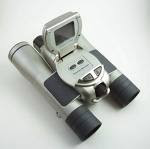
Why do bird-watchers get up so early?
Yeah, yeah - that's when the birds are the most active, sure. But there may be another reason: if the bird-watchers in your family are the only ones in the field by 5 a.m., who could doubt their claim to have seen the elusive bittern, siskin, shrike or blue-footed booby?
After all, bird-watching is an intensely private affair. It's just you and your binoculars. Nobody else sees what you're seeing. And once you've seen it, nobody else ever will.
Or at least that's how it used to be, before the invention of binoculars with built-in digital cameras. The appeal to bird-watchers should be obvious: not only can you prove your sightings, but you can also bring home photos or digital movies in search of second opinions or comparisons with your stack of field guides. And it's not just bird-watching; these hybrid gadgets should also appeal to anyone who takes binoculars to sporting events, concerts, the opera and so on.
(Apparently, the proper term is binocular, singular, as in, "Congratulations on the purchase of your new digital binocular." But frankly, that's just as pretentious as barbers who refer to a "quality scissor" or sales clerks at department stores who praise khakis as "a superior pant.")
Now, the idea of camera-binoculars makes obvious, satisfying sense; as hybrid gadgets go, they rank right up there with the clock radio and the toaster oven. You should be warned, though, that the majority of digital binocs sold through catalogs in the $50 to $80 range are no-name models that take camera-phone-quality 640-by-480-pixel photos. If you really did see a buff-bellied pipit on your roof, you'd be better off drawing it with crayons.
Fortunately, some of the big-name binocular makers have taken this category more seriously. The four models they submitted for review - the Bushnell Instant Replay and Compact Instant Replay, the Celestron VistaPix and the Meade CaptureView CV-4 - are excellent binoculars in the $160 to $425 range.
As for the digital photo part - well, you get the distinct impression that these sporting equipment companies are still a little new at the game. The photo resolution is fairly low: two or three megapixels, suitable for 8-by-10 prints at best. A lot of typical digital camera features are missing, too, including optical zoom, rechargeable batteries and flash (not that a flash would be useful at 100 feet). These are fixed-focus cameras, too.
Most alarming of all, the photo quality on some of these models ranges from mediocre - too many shots wind up blurry, a casualty of the camera shake that results from such powerful magnification - to worthless, especially when indoors and in twilight. If you're used to real digital cameras, your disappointment in the results will range from mild to hysterical. More on this topic in a moment (and at http://www.nytimes.com/circuits, where you can see some sample shots).
All four models are ruggedly built and offer 8X magnification. All four let you turn on the camera portion independently (the binocs always work). All four take AA or AAA batteries, and munch through them in less than an afternoon. All four come with a carrying case, straps and a cable for showing your photos on a TV. All can easily transfer photos and movies to a Windows computer (described in the manuals) and Mac OS X (not mentioned).
All but the Celestron can also film away as you watch, then store a digital movie - at the touch of a button - of only the last 10 or 20 seconds. This feature, called Instant Replay or Flashback, is so useful that it ought to make its way into digital cameras and camcorders.
What's so smart about the idea is that it perfectly suits the kinds of situations for which you use binoculars. Waiting for that dark-eyed junco to emerge from its hole? Instant Replay throws away all the boring waiting-around footage and retains only the magic moment. Tracking your child on the soccer field? Tap the button to retain only the goal-making part. Not sure when your youngster's name will be called to collect the diploma or karate trophy? Start filming when the last names approach yours alphabetically; you'll store only the truly important one.
This is a new product category, so there's no standard definition of a digi-binoc. It's downright charming to see how differently these companies have dreamed up their takes on the same task.
The most oddball model, for sure, is the Meade CaptureView CV-4 8x30 (about $180), a two-megapixel model that in May will be joined by the 3.2-megapixel CV-6 with what the company says is improved low-light sensitivity. (The first number of specs for binoculars, the 8 here, indicates the degree of magnification. The second, 30, is the diameter of each lens; higher numbers mean a brighter image. As for the prices cited here: they come from Amazon.com, shopper.com and www.bhphoto.com. Cam-binocs are such a new category that it's hard to find them all on any one price-comparison site.
Some of the Meade's eccentricities are extremely desirable. For example, it's the only waterproof model in this roundup. And when you connect the U.S.B. cable to your Mac or PC, the camera draws all its power from the computer instead of draining the batteries. (How do you know this? Because the flap that reveals the U.S.B. connector is also the top of the battery compartment, and opening it pulls the upper contacts away from the batteries.)
Other quirks are less delightful. The Meade's binocular focus knob, for example, is on the underside, where it's difficult to reach. All four models feature a tiny (1.5 inches) liquid-crystal display screen that lets you frame and play back your photos, but the Meade's screen is the only one that doesn't pop up. It lies flat on the upper surface of the binoculars (for waterproofness, says the company). To see the screen, you have to turn the binocs 90 degrees, pointing at the sky. So much for the yellow-rumped warbler you were trying to photograph on your suet feeder.
The two-megapixel Celestron VistaPix 8x32 (around $160) has its ups and downs, too. It has separate, dedicated Photo and Movie buttons, which is more important than you might imagine; as the rare red-flanked bluetail alights on a fence post, the last thing you want to do is waste time burrowing into the menus to switch from movie mode to photo mode. (The Bushnell Instant Replay offers this feature, too.)
On the other hand, the Celestron's eyecups extend only slightly behind the hard plastic body, meaning almost certain bruising for any but the most plastic-surged noses. And the Celestron's status as the least expensive model is clearly evident when you look at the fruits of its circuitry. The low-light photos are disastrous, and the movies have all the clarity of that old "Bigfoot in the forest" film.
Bushnell's three-megapixel Instant Replay 8x32 model ($425) is big, black and military-looking. In the binocular department, it blows away its competition: the binocular image is the biggest and the brightest, focusing is easy and precise, and the controls are cleanly designed.
Moreover, this is the only model whose camera sensor records exactly what the binoculars see; on the other models, the camera has its own separate lens, so the photos may not match exactly what you saw.
Too bad about the photo and video part. The image quality is just so-so, both in the photos and on the pop-up screen; the manual's suggestion that you use the coarse, washed-out L.C.D. for focusing makes you mutter, "Easy for you to say."
Clearly, Bushnell is capable of doing better, though, because its newer, smaller Compact Instant Replay (also called the ImageView) gets almost everything right. The screen is bright and sharp, and the 3.1-megapixel photos are nothing to be ashamed of, tying the Meade for best of breed.
These are also the only binoculars that can take TV-quality movies (640 by 480 pixels, 30 frames per second), which is state of the art even by digital camera standards. Too bad you have to burrow into a menu to switch from movie to photo mode, but at least the menus are big, bold and easy to navigate. And the price - $220 from stores like cabelas.com - is right.
Now, camera enthusiasts may be snickering already. "Three megapixels? Grainy photos? 8X zoom? Why, my regular digital camera takes five-megapixel photos that look sensational - and it's got a 10X zoom lens! Why would I buy a wannabe like these binoculars?"
There's some merit in that argument (if you ignore the fact that digital cameras with 7X to 10X zooms cost a lot more). But just as you wouldn't want a pair of binoculars as your sole recording instrument at a family reunion, so you wouldn't want to use a digital camera for minutes-at-a-time watching. That's something that binoculars - with their big, bright, rubber-lined eyepieces - make comfortable and effective.
And now, thanks to the integration of basic digital photo features, you can do more with these binocs than sit out in the bushes for hours at a time while the sun comes up. At last, you can bring home proof of what you've been up to. find the best buy on digital binoculars
Sizing Up a New Species: Camera-Binoculars
Subscribe to:
Posts (Atom)







